Evaluating the Factors Affecting QoE of 360-Degree Videos and Cybersickness Levels Predictions in Virtual Reality
Abstract
1. Introduction
- First, we simulate two different types of stalling events including one long stalling of 9-s and three short stalling of 3-s each ( s) in nine different types of 360-degree videos to cover various influencing factors that affect the users QoE in the VR. The impact of these factors under various stalling events on users’ QoE is investigated. To the best of our knowledge, no previous studies have addressed the effect of stalling on the user’s cybersickness level for 360-degree videos in VR;
- Second, we conduct a subjective experiment including 40 subjects and investigate the impact of content type (fast, medium, and slow), camera motion (fixed, vertical, and horizontal), and the number of moving targets (no target, single target, and multiple targets) on users’ QoE. The QoE is then evaluated in terms of three significant aspects, such as perceptual quality, presence, and cybersickness;
- Third, to evaluate the viewing safety concerns in VR, we propose a neural network-based QoE prediction technique that predicts and examines the degree of cybersickness induced by the 360-degree videos under various stalling events in VR. The prediction accuracy of the proposed method performs well against well-known ML methods such as Support Vector Machine (SVM), K-Nearest Neighbors (KNN), and Decision Tree (DT). Our proposed method outperforms existing QoE methods.
2. Related Work
3. Experimental Setup and Description
3.1. Subjective Users Study and Technical Setup
3.2. Subjective Experiment
- Q1: How do you perceive the quality of video on a 5-point scale? (MOS), (1 = bad, 5 = excellent);
- Q2: How do you rate the level of cybersickness (dizziness or nausea) whilst watching in VR on a 4-point scale? (SSQ), (0; no sickness, 1; mild sickness, 2; considerable sickness, 3; severe sickness);
- Q3: I had a sense of being there in a virtual environment (IPQ-G1), (5 = fully agree, 1 = fully disagree).
4. Subjective Results Analysis and Discussions
4.1. Impact on Perceptual Quality
4.2. Impact on Presence
4.3. Impact on Cybersickness
5. QoE Prediction in Terms of Cybersickness
| Algorithm 1 Learning neural network-based QoE prediction model with cybersickness data. |
| Initialize: Set the neural network learning rate as 0.2 and the iteration number (epochs) to train the network as 1000. Select the hidden neuron in first and second hidden layer as 64 and 32, respectively. |
|
6. Accuracy and Performance Comparison
7. Conclusions
Author Contributions
Funding
Conflicts of Interest
References
- Brunnström, K.; Beker, S.A.; De Moor, K.; Dooms, A.; Egger, S.; Garcia, M.N.; Hossfeld, T.; Jumisko-Pyykkö, S.; Keimel, C.; Larabi, M.C.; et al. Qualinet white paper on definitions of quality of experience. In European Network on Quality of Experience in Multimedia Systems and Services (COST Action IC 1003); EU COST: Lausanne, Switzerland, 2012; Volume 3. [Google Scholar]
- Seufert, M.; Egger, S.; Slanina, M.; Zinner, T.; Hoßfeld, T.; Tran-Gia, P. A survey on quality of experience of HTTP adaptive streaming. IEEE Commun. Surv. Tutor. 2014, 17, 469–492. [Google Scholar] [CrossRef]
- Garcia, M.N.; De Simone, F.; Tavakoli, S.; Staelens, N.; Egger, S.; Brunnström, K.; Raake, A. Quality of experience and HTTP adaptive streaming: A review of subjective studies. In Proceedings of the 2014 Sixth International Workshop on Quality of Multimedia Experience (QoMEX), Singapore, 18–20 September 2014; pp. 141–146. [Google Scholar]
- Tran, H.T.; Ngoc, N.P.; Pham, A.T.; Thang, T.C. A multi-factor QoE model for adaptive streaming over mobile networks. In Proceedings of the 2016 IEEE Globecom Workshops (GC Wkshps), Washington, DC, USA, 4–8 December 2016; pp. 1–6. [Google Scholar]
- Kennedy, R.S.; Lane, N.E.; Berbaum, K.S.; Lilienthal, M.G. Simulator sickness questionnaire: An enhanced method for quantifying simulator sickness. Int. J. Aviat. Psychol. 1993, 3, 203–220. [Google Scholar] [CrossRef]
- Gianaros, P.J.; Muth, E.R.; Mordkoff, J.T.; Levine, M.E.; Stern, R.M. A questionnaire for the assessment of the multiple dimensions of motion sickness. Aviat. Space Environ. Med. 2001, 72, 115. [Google Scholar] [PubMed]
- Ameigeiras, P.; Azcona-Rivas, A.; Navarro-Ortiz, J.; Ramos-Munoz, J.J.; Lopez-Soler, J.M. A simple model for predicting the number and duration of rebuffering events for YouTube flows. IEEE Commun. Lett. 2011, 16, 278–280. [Google Scholar] [CrossRef]
- Budagavi, M.; Furton, J.; Jin, G.; Saxena, A.; Wilkinson, J.; Dickerson, A. 360 degrees video coding using region adaptive smoothing. In Proceedings of the 2015 IEEE International Conference on Image Processing (ICIP), Quebec City, QC, Canada, 27–30 September 2015; pp. 750–754. [Google Scholar]
- Ng, K.T.; Chan, S.C.; Shum, H.Y. Data compression and transmission aspects of panoramic videos. IEEE Trans. Circuits Syst. Video Technol. 2005, 15, 82–95. [Google Scholar]
- Bauermann, I.; Mielke, M.; Steinbach, E.H. 264 based coding of omnidirectional video. In Computer Vision and Graphics; Springer: Berlin/Heidelberg, Germany, 2006; pp. 209–215. [Google Scholar]
- Yu, M.; Lakshman, H.; Girod, B. A framework to evaluate omnidirectional video coding schemes. In Proceedings of the 2015 IEEE International Symposium on Mixed and Augmented Reality; Institute of Electrical and Electronics Engineers (IEEE), Fukuoka, Japan, 29 September–3 October 2015; pp. 31–36. [Google Scholar]
- Upenik, E.; Řeřábek, M.; Ebrahimi, T. Testbed for subjective evaluation of omnidirectional visual content. In Proceedings of the 2016 Picture Coding Symposium (PCS), Nuremberg, Germany, 4–7 December 2016; pp. 1–5. [Google Scholar]
- Sodagar, I. The mpeg-dash standard for multimedia streaming over the internet. IEEE Multimed. 2011, 18, 62–67. [Google Scholar] [CrossRef]
- Zare, A.; Aminlou, A.; Hannuksela, M.M.; Gabbouj, M. HEVC-compliant tile-based streaming of panoramic video for virtual reality applications. In Proceedings of the 24th ACM International Conference on Multimedia, Amsterdam, The Netherlands, 15–19 October 2016; pp. 601–605. [Google Scholar]
- Qian, F.; Ji, L.; Han, B.; Gopalakrishnan, V. Optimizing 360 video delivery over cellular networks. In Proceedings of the 5th Workshop on All Things Cellular: Operations, Applications and Challenges, New York, NY, USA, 3–7 October 2016; pp. 1–6. [Google Scholar]
- Cheung, G.; Liu, Z.; Ma, Z.; Tan, J.Z. Multi-stream switching for interactive virtual reality video streaming. In Proceedings of the 2017 IEEE International Conference on Image Processing (ICIP), Beijing, China, 17–20 September 2017; pp. 2179–2183. [Google Scholar]
- Hosseini, M.; Swaminathan, V. Adaptive 360 VR video streaming: Divide and conquer. In Proceedings of the 2016 IEEE International Symposium on Multimedia (ISM), San Jose, CA, USA, 11–13 December 2016; pp. 107–110. [Google Scholar]
- Huynh-Thu, Q.; Ghanbari, M. Temporal aspect of perceived quality in mobile video broadcasting. IEEE Trans. Broadcast. 2008, 54, 641–651. [Google Scholar] [CrossRef]
- Singh, K.D.; Hadjadj-Aoul, Y.; Rubino, G. Quality of experience estimation for adaptive HTTP/TCP video streaming using H. 264/AVC. In Proceedings of the 2012 IEEE Consumer Communications and Networking Conference (CCNC), Las Vegas, NV, USA, 14–17 January 2012; pp. 127–131. [Google Scholar]
- Singla, A.; Fremerey, S.; Robitza, W.; Raake, A. Measuring and comparing QoE and simulator sickness of omnidirectional videos in different head mounted displays. In Proceedings of the 2017 Ninth International Conference on Quality of Multimedia Experience (QoMEX), Erfurt, Germany, 31 May–2 June 2017; pp. 1–6. [Google Scholar]
- Yao, S.H.; Fan, C.L.; Hsu, C.H. Towards quality-of-experience models for watching 360 videos in head-mounted virtual reality. In Proceedings of the 2019 Eleventh International Conference on Quality of Multimedia Experience (QoMEX), Berlin, Germany, 5–7 June 2019; pp. 1–3. [Google Scholar]
- Nasrabadi, A.T.; Samiei, A.; Mahzari, A.; McMahan, R.P.; Prakash, R.; Farias, M.C.; Carvalho, M.M. A taxonomy and dataset for 360∘ videos. In Proceedings of the 10th ACM Multimedia Systems Conference, Amherst, MA, USA, 18–21 June 2019; pp. 273–278. [Google Scholar]
- TT Tran, H.; Ngoc, N.P.; Pham, C.T.; Jung, Y.J.; Thang, T.C. A Subjective Study on User Perception Aspects in Virtual Reality. Appl. Sci. 2019, 9, 3384. [Google Scholar] [CrossRef]
- Singla, A.; Göring, S.; Raake, A.; Meixner, B.; Koenen, R.; Buchholz, T. Subjective quality evaluation of tile-based streaming for omnidirectional videos. In Proceedings of the 10th ACM Multimedia Systems Conference, Amherst, MA, USA, 18–21 June 2019; pp. 232–242. [Google Scholar]
- Gaggioli, A. Quality of experience in real and virtual environments: Some suggestions for the development of positive technologies. Stud. Heal. Technol. Inform. 2012, 181, 177–180. [Google Scholar]
- Steed, A.; Frlston, S.; Lopez, M.M.; Drummond, J.; Pan, Y.; Swapp, D. An ‘in the wild’experiment on presence and embodiment using consumer virtual reality equipment. IEEE Trans. Vis. Comput. Graph. 2016, 22, 1406–1414. [Google Scholar] [CrossRef]
- Tran, H.T.; Hoang, T.H.; Minh, P.N.; Ngoc, N.P.; Thang, T.C. A perception-based quality metric for omnidirectional images. In Proceedings of the 2019 IEEE International Conference on Consumer Electronics-Asia (ICCE-Asia), Bangkok, Thailand, 12–14 June 2019; pp. 151–152. [Google Scholar]
- Schatz, R.; Sackl, A.; Timmerer, C.; Gardlo, B. Towards subjective quality of experience assessment for omnidirectional video streaming. In Proceedings of the 2017 Ninth International Conference on Quality of Multimedia Experience (QoMEX), Erfurt, Germany, 31 May–2 June 2017; pp. 1–6. [Google Scholar]
- Anwar, M.S.; Wang, J.; Ullah, A.; Khan, W.; Li, Z.; Ahmad, S. User Profile Analysis for Enhancing QoE of 360 Panoramic Video in Virtual Reality Environment. In Proceedings of the 2018 International Conference on Virtual Reality and Visualization (ICVRV), Qingdao, China, 22–24 October 2018; pp. 106–111. [Google Scholar]
- Muhammad, A.; Jing, W.; ULLAH, A.; Wahab, K.; Sadique, A.; Zesong, F. Measuring Quality of Experience for 360-degree Videos in Virtual Reality. Sci. China Inf. Sci. 2020, 63, 1–15. [Google Scholar]
- Tran, H.T.; Pham, C.T.; Ngoc, N.P.; Pham, A.T.; Thang, T.C. A study on quality metrics for 360 video communications. IEICE Trans. Inf. Syst. 2018, 101, 28–36. [Google Scholar] [CrossRef]
- Melo, M.; Vasconcelos-Raposo, J.; Bessa, M. Presence and cybersickness in immersive content: Effects of content type, exposure time and gender. Comput. Graph. 2018, 71, 159–165. [Google Scholar] [CrossRef]
- Singla, A.; Fremerey, S.; Robitza, W.; Lebreton, P.; Raake, A. Comparison of subjective quality evaluation for hevc encoded omnidirectional videos at different bit-rates for uhd and fhd resolution. In Proceedings of the on Thematic Workshops of ACM Multimedia 2017, Mountain View, CA, USA, 23–27 October 2017; pp. 511–519. [Google Scholar]
- Duan, H.; Zhai, G.; Yang, X.; Li, D.; Zhu, W. IVQAD 2017: An immersive video quality assessment database. In Proceedings of the 2017 International Conference on Systems, Signals and Image Processing (IWSSIP), Poznan, Poland, 22–24 May 2017; pp. 1–5. [Google Scholar]
- Tran, H.T.; Ngoc, N.P.; Bui, C.M.; Pham, M.H.; Thang, T.C. An evaluation of quality metrics for 360 videos. In Proceedings of the 2017 Ninth International Conference on Ubiquitous and Future Networks (ICUFN), Milan, Italy, 4–7 July 2017; pp. 7–11. [Google Scholar]
- Zhang, B.; Zhao, J.; Yang, S.; Zhang, Y.; Wang, J.; Fei, Z. Subjective and objective quality assessment of panoramic videos in virtual reality environments. In Proceedings of the 2017 IEEE International Conference on Multimedia & Expo Workshops (ICMEW), Hong Kong, China, 10–14 July 2017; pp. 163–168. [Google Scholar]
- Anwar, M.S.; Wang, J.; Khan, W.; Ullah, A.; Ahmad, S.; Fei, Z. Subjective QoE of 360-Degree Virtual Reality Videos and Machine Learning Predictions. IEEE Access 2020, 8, 148084–148099. [Google Scholar] [CrossRef]
- Anwar, M.S.; Wang, J.; Ullah, A.; Khan, W.; Ahmad, S.; Li, Z. Impact of Stalling on QoE for 360-degree Virtual Reality Videos. In Proceedings of the 2019 IEEE International Conference on Signal, Information and Data Processing (ICSIDP), Chongqing, China, 11–13 December 2019; pp. 1–6. [Google Scholar]
- Tran, H.T.; Ngoc, N.P.; Pham, C.T.; Jung, Y.J.; Thang, T.C. A subjective study on QoE of 360 video for VR communication. In Proceedings of the 2017 IEEE 19th International Workshop on Multimedia Signal Processing (MMSP), Lodon, UK, 6–18 October 2017; pp. 1–6. [Google Scholar]
- Kim, Y.Y.; Kim, H.J.; Kim, E.N.; Ko, H.D.; Kim, H.T. Characteristic changes in the physiological components of cybersickness. Psychophysiology 2005, 42, 616–625. [Google Scholar] [CrossRef] [PubMed]
- Rebenitsch, L.; Owen, C. Review on cybersickness in applications and visual displays. Virtual Real. 2016, 20, 101–125. [Google Scholar] [CrossRef]
- Hettinger, L.J.; Riccio, G.E. Visually induced motion sickness in virtual environments. Presence Teleoperators Virtual Environ. 1992, 1, 306–310. [Google Scholar] [CrossRef]
- Fremerey, S.; Singla, A.; Meseberg, K.; Raake, A. AVtrack360: An open dataset and software recording people’s head rotations watching 360∘ videos on an HMD. In Proceedings of the 9th ACM Multimedia Systems Conference, Amsterdam, The Netherlands, 12–15 June 2018; pp. 403–408. [Google Scholar]
- Stauffert, J.P.; Niebling, F.; Latoschik, M.E. Towards comparable evaluation methods and measures for timing behavior of virtual reality systems. In Proceedings of the 22nd ACM Conference on Virtual Reality Software and Technology, Munich, Germany, 2–4 November 2016; pp. 47–50. [Google Scholar]
- Zielinski, D.J.; Rao, H.M.; Sommer, M.A.; Kopper, R. Exploring the effects of image persistence in low frame rate virtual environments. In Proceedings of the 2015 IEEE Virtual Reality (VR), Houston, TX, USA, 13–17 March 2015; pp. 19–26. [Google Scholar]
- Fernandes, A.S.; Feiner, S.K. Combating VR sickness through subtle dynamic field-of-view modification. In Proceedings of the 2016 IEEE Symposium on 3D User Interfaces (3DUI), Greenville, SC, USA, 19–20 March 2016; pp. 201–210. [Google Scholar]
- Carnegie, K.; Rhee, T. Reducing visual discomfort with HMDs using dynamic depth of field. IEEE Comput. Graph. Appl. 2015, 35, 34–41. [Google Scholar] [CrossRef]
- Egan, D.; Brennan, S.; Barrett, J.; Qiao, Y.; Timmerer, C.; Murray, N. An evaluation of Heart Rate and ElectroDermal Activity as an objective QoE evaluation method for immersive virtual reality environments. In Proceedings of the 2016 Eighth International Conference on Quality of Multimedia Experience (QoMEX), Lisbon, Portugal, 6–8 June 2016; pp. 1–6. [Google Scholar]
- Staelens, N.; Moens, S.; Van den Broeck, W.; Marien, I.; Vermeulen, B.; Lambert, P.; Van de Walle, R.; Demeester, P. Assessing quality of experience of IPTV and video on demand services in real-life environments. IEEE Trans. Broadcast. 2010, 56, 458–466. [Google Scholar] [CrossRef]
- Regenbrecht, H.; Schubert, T. Real and illusory interactions enhance presence in virtual environments. Presence Teleoperators Virtual Environ. 2002, 11, 425–434. [Google Scholar] [CrossRef]
- Rebenitsch, L.R. Cybersickness Prioritization and Modeling; Michigan State University: East Lansing, MI, USA, 2015. [Google Scholar]
- Bruck, S.; Watters, P.A. Estimating cybersickness of simulated motion using the simulator sickness questionnaire (SSQ): A controlled study. In Proceedings of the 2009 Sixth International Conference on Computer Graphics, Imaging and Visualization; Institute of Electrical and Electronics Engineers (IEEE), Tianjin, China, 11–14 August 2009; pp. 486–488. [Google Scholar]
- Kim, J.; Kim, W.; Ahn, S.; Kim, J.; Lee, S. Virtual reality sickness predictor: Analysis of visual-vestibular conflict and vr contents. In Proceedings of the 2018 Tenth International Conference on Quality of Multimedia Experience (QoMEX), Sardinia, Italy, 29–31 May 2018; pp. 1–6. [Google Scholar]
- Kim, H.G.; Lim, H.T.; Lee, S.; Ro, Y.M. Vrsa net: Vr sickness assessment considering exceptional motion for 360 vr video. IEEE Trans. Image Process. 2018, 28, 1646–1660. [Google Scholar] [CrossRef] [PubMed]
- Jeong, H.; Kim, H.G.; Ro, Y.M. Visual comfort assessment of stereoscopic images using deep visual and disparity features based on human attention. In Proceedings of the 2017 IEEE International Conference on Image Processing (ICIP), Beijing, China, 17–20 September 2017; pp. 715–719. [Google Scholar]


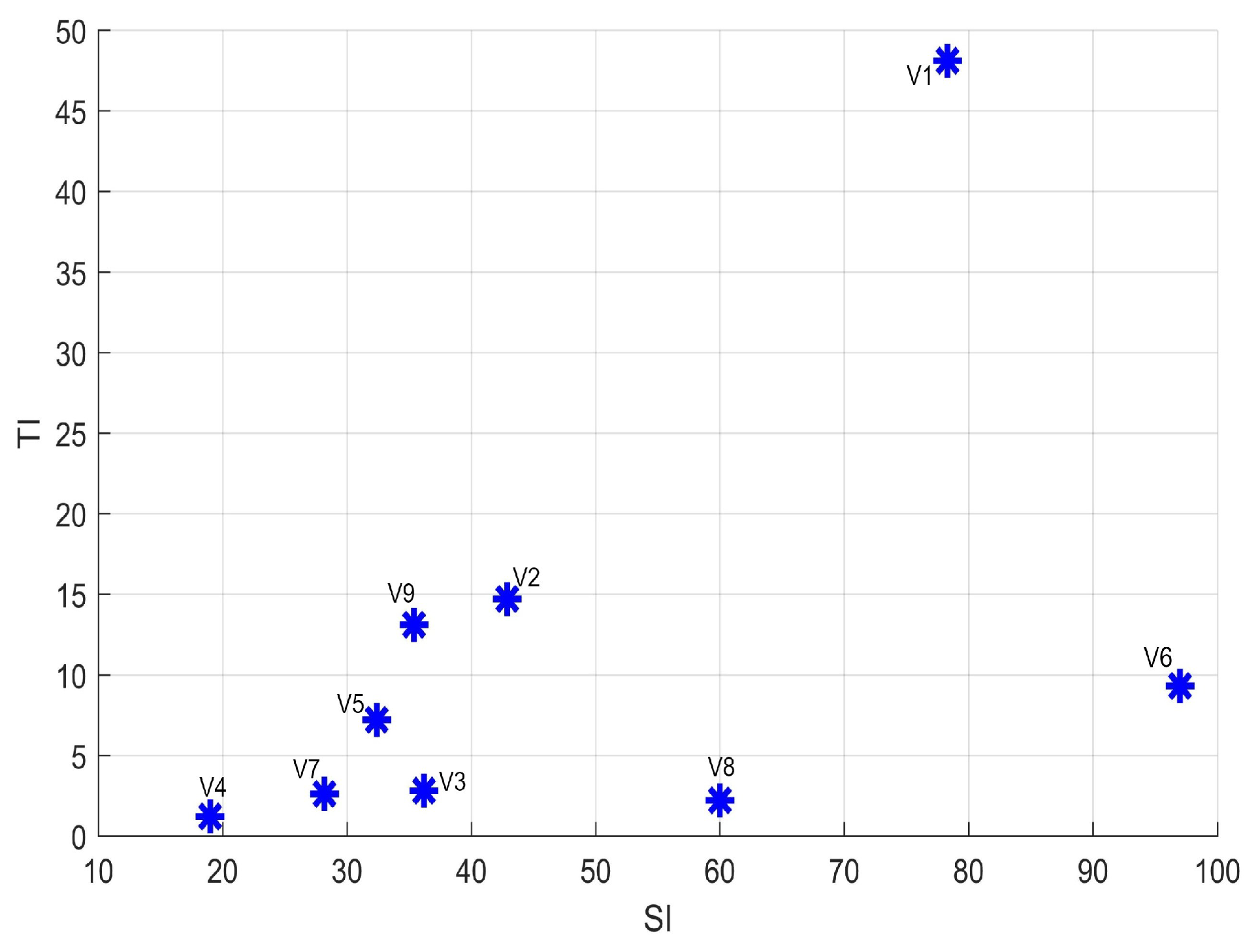




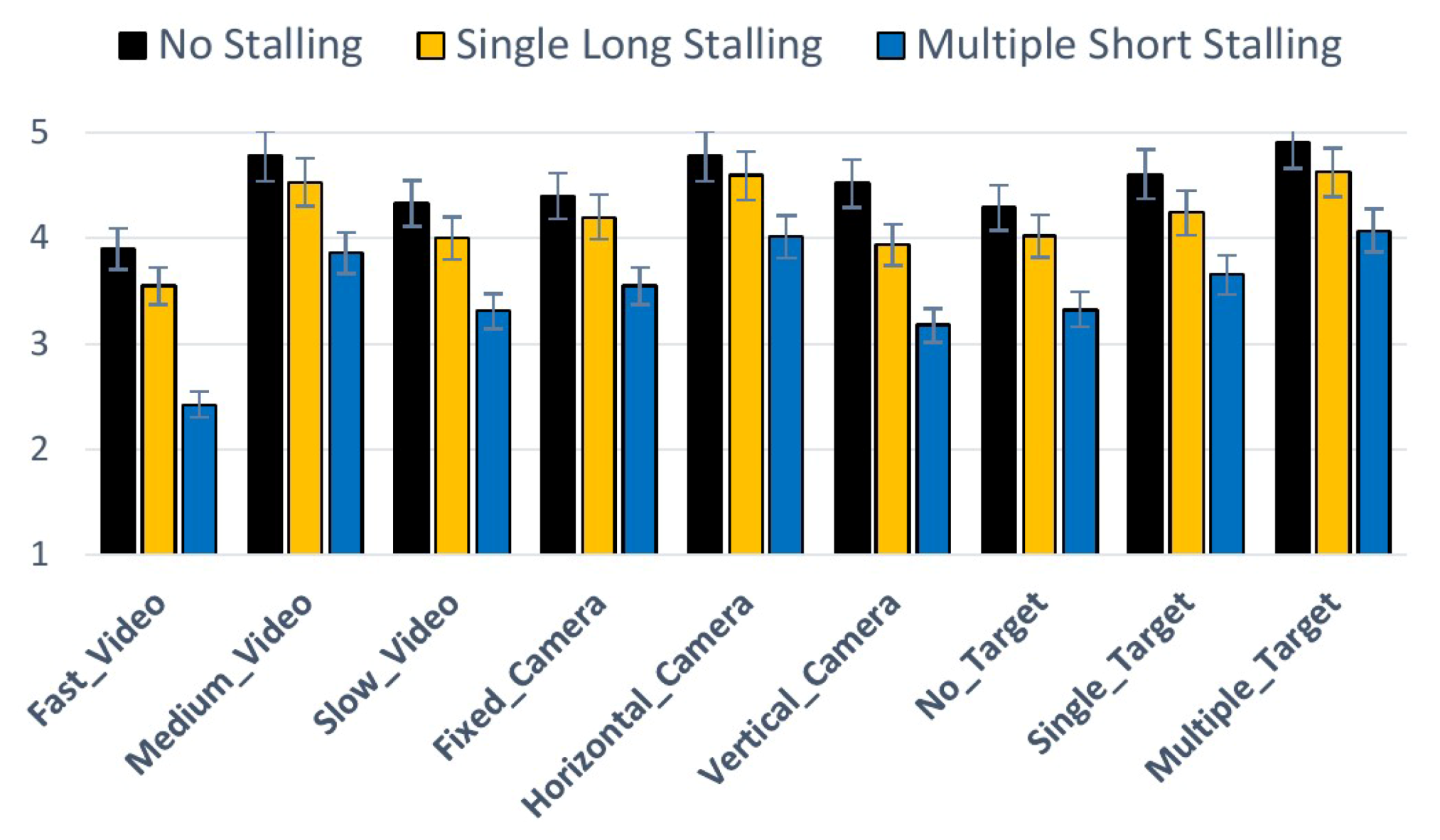

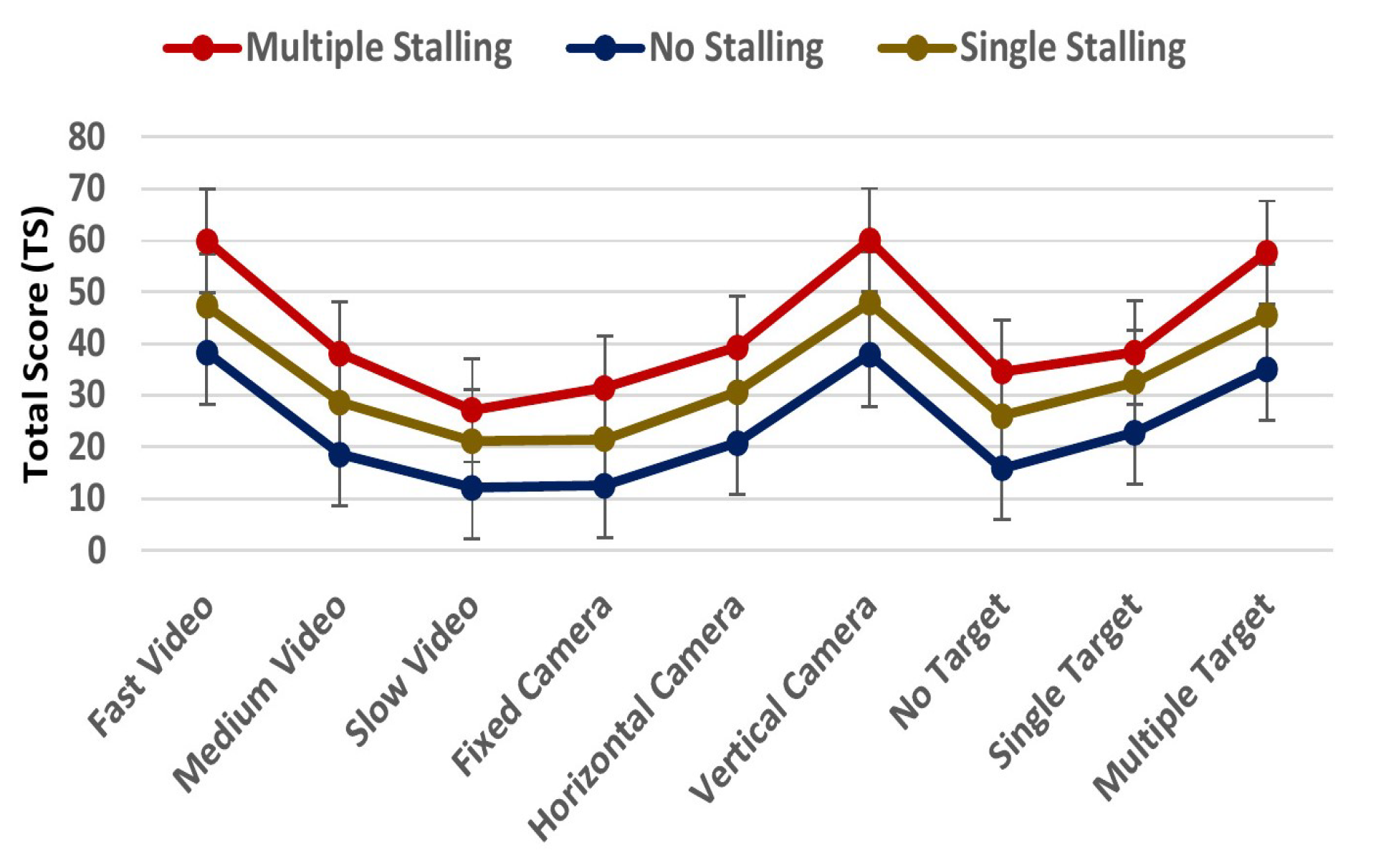

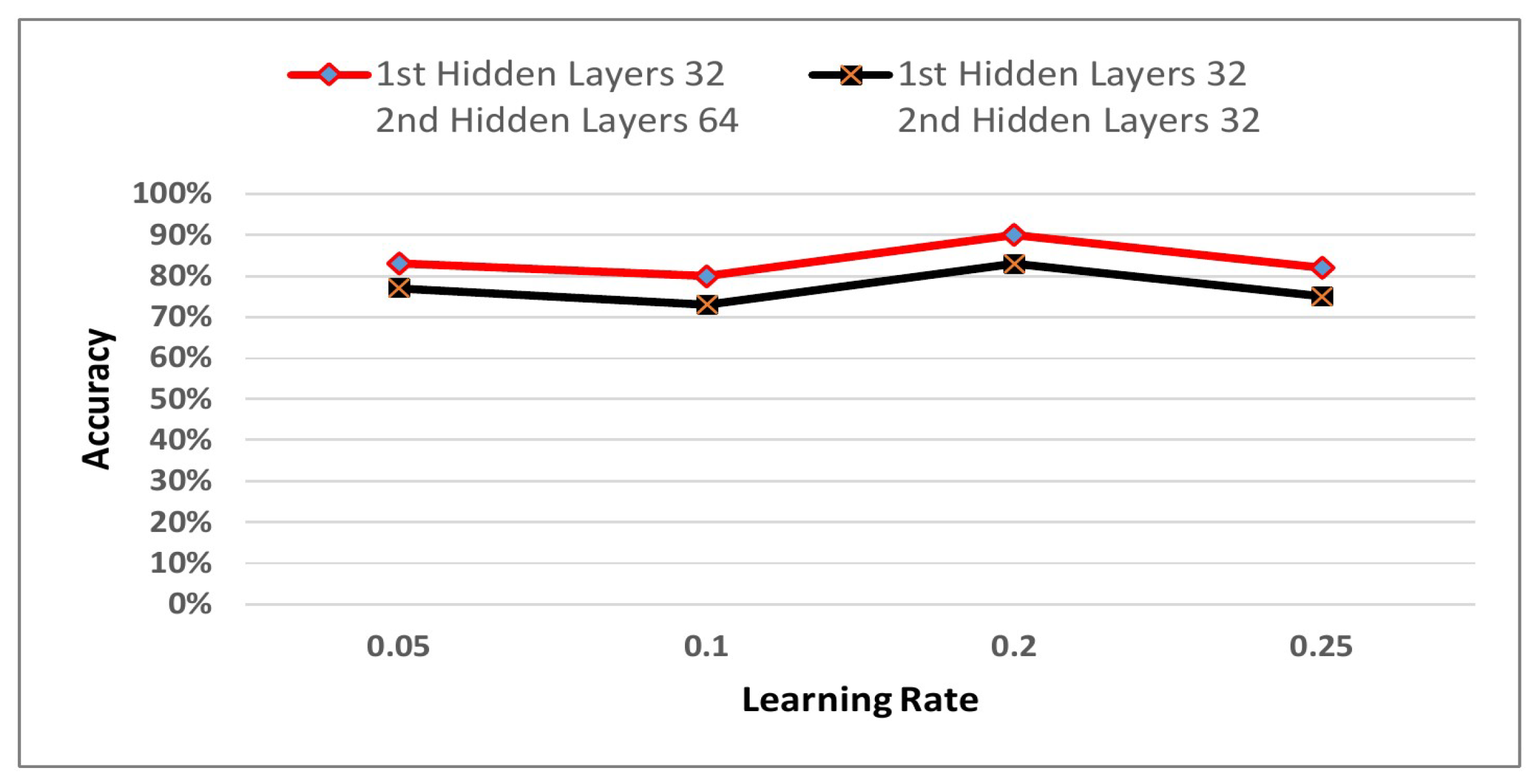
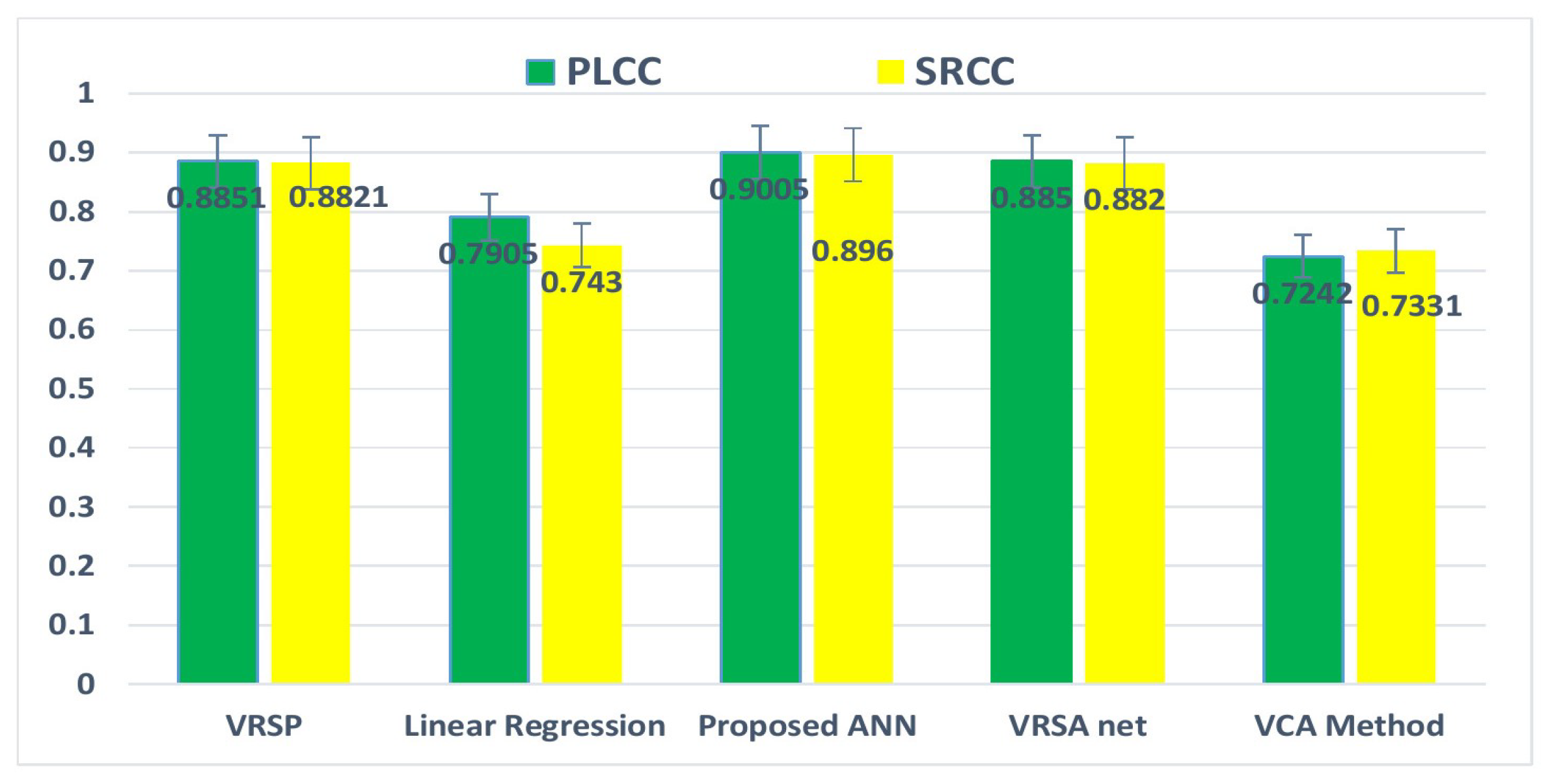
| Factors | Features | Name | Video ID (YouTube) | Resolutions | Frame Rate |
|---|---|---|---|---|---|
| Content Type | Fast | V1 | 8lsB-P8nGSM | 3840 × 1920 | 30 fps |
| Medium | V2 | D9-i_F3XYhI | 3840 × 1920 | 30 fps | |
| Slow | V3 | mlOiXMvMaZo | 3840 × 2160 | 30 fps | |
| Camera Motion | Fixed | V4 | ESRz3-btZIA | 3840 × 1920 | 25 fps |
| Horizontal | V5 | 9 XR2CZi3V5k | 3840 × 1920 | 25 fps | |
| Vertical | V6 | elhdcvKhgbA | 3840 × 1920 | 25 fps | |
| Moving Target | No Target | V7 | L_tqK4eqelA | 3840 × 2160 | 29 fps |
| Single target | V8 | ULiXPLH-WA4 | 3840 × 2048 | 29 fps | |
| Multiple Targets | V9 | p9h3ZqJa1iA | 3840 × 2160 | 25 fps |
| SSQ Symptoms (0,1,2,3) | N | O | D |
|---|---|---|---|
| General discomfort | 1 | 1 | |
| Fatigue | 1 | ||
| Headache | 1 | ||
| Eye strain | 1 | ||
| Difficulty focusing | 1 | 1 | |
| Increased salivation | 1 | ||
| Sweating | 1 | ||
| Nausea | 1 | 1 | |
| Difficulty concentrating | 1 | 1 | |
| Fullness of head | 1 | ||
| Blurred vision | 1 | 1 | |
| Dizzy (Eye open) | 1 | ||
| Dizzy (Eye closed) | 1 | ||
| Vertigo | 1 | ||
| Stomach awareness | 1 | ||
| Burping | 1 | ||
| Total | [a] | [b] | [c] |
| Questions | PLCC | SRCC |
|---|---|---|
| Q1 | 0.8834 | 0.8735 |
| Q2 | 0.9005 | 0.8961 |
| Q3 | 0.9015 | 0.8912 |
| Total Score (TS) | Sickness Level | Output Variable |
|---|---|---|
| 0 to 10 | Normal Sickness | 0 |
| 11 to 31 | Slight Sickness | 1 |
| 32 to 40 | Enough Sickness | 2 |
| 40 above | Severe Sickness | 3 |
| Method | Precision | Recall | f1-Score | MAE | Accuracy |
|---|---|---|---|---|---|
| KNN | 0.84 | 0.82 | 0.83 | 0.19 | |
| ANN | 0.91 | 0.91 | 0.90 | 0.9 | |
| SVM | 0.85 | 0.83 | 0.82 | 0.18 | |
| DT | 0.87 | 0.83 | 0.82 | 0.17 |
© 2020 by the authors. Licensee MDPI, Basel, Switzerland. This article is an open access article distributed under the terms and conditions of the Creative Commons Attribution (CC BY) license (http://creativecommons.org/licenses/by/4.0/).
Share and Cite
Shahid Anwar, M.; Wang, J.; Ahmad, S.; Ullah, A.; Khan, W.; Fei, Z. Evaluating the Factors Affecting QoE of 360-Degree Videos and Cybersickness Levels Predictions in Virtual Reality. Electronics 2020, 9, 1530. https://doi.org/10.3390/electronics9091530
Shahid Anwar M, Wang J, Ahmad S, Ullah A, Khan W, Fei Z. Evaluating the Factors Affecting QoE of 360-Degree Videos and Cybersickness Levels Predictions in Virtual Reality. Electronics. 2020; 9(9):1530. https://doi.org/10.3390/electronics9091530
Chicago/Turabian StyleShahid Anwar, Muhammad, Jing Wang, Sadique Ahmad, Asad Ullah, Wahab Khan, and Zesong Fei. 2020. "Evaluating the Factors Affecting QoE of 360-Degree Videos and Cybersickness Levels Predictions in Virtual Reality" Electronics 9, no. 9: 1530. https://doi.org/10.3390/electronics9091530
APA StyleShahid Anwar, M., Wang, J., Ahmad, S., Ullah, A., Khan, W., & Fei, Z. (2020). Evaluating the Factors Affecting QoE of 360-Degree Videos and Cybersickness Levels Predictions in Virtual Reality. Electronics, 9(9), 1530. https://doi.org/10.3390/electronics9091530







